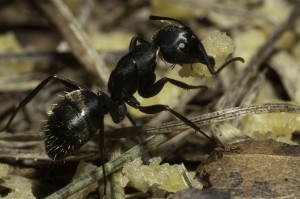
Carpenter ants
often hollow out wood for nesting.
A: In early spring, the ants are just coming out of hibernation and are looking for proteins. Protein gel baits are probably your best choice. However, it has been my experience carpenter ants often change food preferences regularly. Therefore, be prepared for acceptance changes and have a sugar gel or liquid sugar bait available. Based on my experience, carpenter ants don’t accept many granular baits readily.
Q: Some wooden stools arrived from overseas, and they have powderpost beetles in them. Many years ago I remember fumigating wooden artifacts at a museum with 1,4-Dichlorobenzene crystals. It seemed to work because emergence didn’t occur afterward. Is this still legal? If so, will it work? B.C., N.Y.
A: Also known as para-dichlorobenzene or p-DCB, this organic compound is classified as a fumigant but doesn’t penetrate well. In your past case, emergence probably ceased because all of the adults were gone, and there was no second generation. p-DCB is still legal to use, but I don’t know of any registered products. In the case of your stools, have them fumigated with a modern fumigant such sulfuryl fluoride or consider using heat to kill any infestation.
Q: A customer has digger bees return every year. Is there a permanent way to prevent such activity? We can control them without a problem, but the customer wants a permanent solution. T.P., Va.
A: The various wasps and bees that dig cells in the soil for egg laying usually pick bare areas of soil. For a permanent solution, cover the area with mulch or thick sod. The mulch can be stone, bark or shredded plant material. The bees won’t attempt to dig in soil that’s covered with sod or mulch.
Q: We encounter swarming ants every year coming from beneath slabs. In the past, we’ve solved most of these problems by drilling and treating the area beneath the slab with a termiticide. However, when we encounter the problem in schools and similar public areas, the notification requirements of our state become burdensome. We’d like to use a “green” product to avoid the notification hassle. What do you suggest? J.O., N.J.
A: The best choice for your swarming ant problem is an appropriately labeled pyrethroid or nonrepellent termiticide. Even then, swarmers might not be killed quickly enough to satisfy the customer. If enough reaches the colony, the customer should have protection against future swarms. Treating during the swarming season usually results in little customer satisfaction. Caulking might be a better answer for quick results, if you can access the entrance openings in the slab.
You can reach Dr. Mampe, an industry consultant, at dentomol@aol.com.
Email your questions about insect identification and pest management technologies and techniques to Dr. Mampe at detomol@aol.com. Your questions most likely will be printed and answered in one of Pest Management Professional’s upcoming Ask the Expert columns.
Leave A Comment